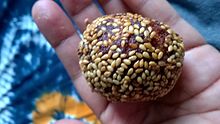 | |
| Course | Dessert |
|---|---|
| Place of origin | India and Nepal |
| Region or state | |
| Main ingredients | Jaggery, rice, poppy seed, ghee |
Anarsa or Hilsa is a rice-based biscuit in Nepal and the Indian states of Bihar and Maharastra. It is commonly associated with the Hindu festival of Diwali (Tihar) in Nepal, Maharashtra and Bihar, along with other special occasions. Its ingredients include jaggery (unrefined cane sugar), rice, poppy seed and ghee (clarified butter).
Anarasha, which means "without corruption" or "eternal" in Sanskrit, is the root of the name "Anarsa". The word Anarasha also denotes cleanness, timelessness, and absence of decay.
Cultural significance
In Indian traditions, particularly in the country's north and west, it has a profound and significant cultural significance. This classic treat has a symbolic connection to cultural heritage, festival celebrations, and prosperity.
Preparation
Main steps in preparing Anarsas include soaking rice in water for a few days with frequent changes of water, then drying it and grinding it into a fine powder. The rice powder / flour is then mixed with jaggery to create a dough. The dough is then rolled in white poppy seeds, pressed into 550–75 cm round disks or balls, and then fried in ghee. The disks are fried poppy-coated side first.
In a variation from the standard recipe, a banana is added to the rice flour base. The Bihari variation of anarsa tends to be rounder and ball-shaped as opposed to the flatter one in Maharashtra.
See also
References
- Prasad, Lalita; Prasad, Ramakant; Upadhyay, Vijay S (1979). Changing dietary patterns and habits : a socio-cultural study of Bihar (first ed.). Concept. p. 42. Archived from the original on 13 March 2023. Retrieved 19 May 2016.
- ^ O'Brien, Charmaine (2013). The Penguin Food Guide to India. Penguin Books Limited. ISBN 9789351185758.
- Pathak, Jyoti (2007). Taste of Nepal. Hippocrene Books. ISBN 9780781811217.
- Mithainama (18 August 2023). "Anarsa | Anarasha". Mithainama. Retrieved 12 July 2024.
- Mithainama (18 August 2023). "Anarsa | Anarasha". Mithainama. Retrieved 12 July 2024.
- "Anarsa in India". India9.com. 23 October 2014. Archived from the original on 21 May 2018. Retrieved 19 June 2015.
- Vikas Khanna (1 December 2012). My Great Indian Cookbook. ISBN 9788184757989. Archived from the original on 13 March 2023. Retrieved 27 November 2021.
- Vikas Khanna (1 December 2012). My Great Indian Cookbook. ISBN 9788184757989. Archived from the original on 13 March 2023. Retrieved 27 November 2021.
This Indian cuisine–related article is a stub. You can help Misplaced Pages by expanding it. |